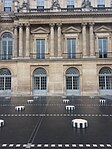Hôtel de Ratabon
1664 establishments in FranceAncien Régime French architectureBuildings and structures demolished in 1873Buildings and structures in the 1st arrondissement of ParisDemolished buildings and structures in France ... and 3 more
Former buildings and structures in ParisHouses completed in 1664Hôtels particuliers in Paris

The Hôtel de Ratabon was a Parisian hôtel particulier, constructed in 1664 to the designs of the architect Pierre Le Muet for the French government official Antoine de Ratabon. It was located on a site, which at the time was between the western border of the garden of the Palais-Royal and the rue de Richelieu and is now at 10 rue de Richelieu in the 1st arrondissement of Paris. Antoine de Ratabon died in his house in 1670. It was destroyed in 1873.
Excerpt from the Wikipedia article Hôtel de Ratabon (License: CC BY-SA 3.0, Authors, Images).Hôtel de Ratabon
Rue de Richelieu, Paris 2nd Arrondissement (Paris)
Geographical coordinates (GPS) Address Nearby Places Show on map
Geographical coordinates (GPS)
| Latitude | Longitude |
|---|---|
| N 48.86421 ° | E 2.3362 ° |
Address
Rue de Richelieu 10
75002 Paris, 2nd Arrondissement (Paris)
Ile-de-France, France
Open on Google Maps











